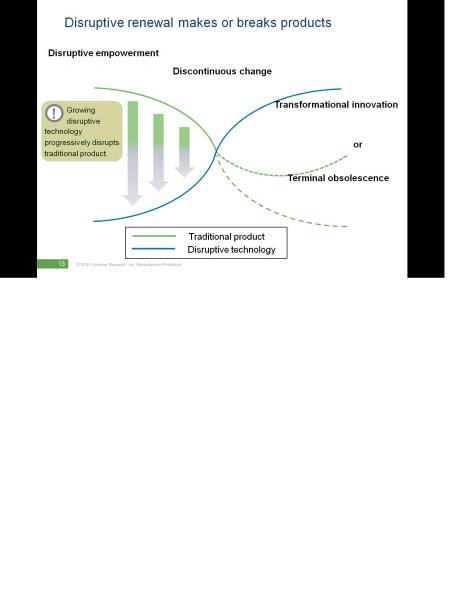Disruptive Renewal
This morning I had the privilege of keynoting Forrester’s EMEA Marketing and Strategy Forum.
My keynote introduced a new stream of research we’re developing in the Consumer Product Strategy role: Disruptive Renewal. We also today published our first report on the topic, which Forrester clients can download here.
The basic principle of Disruptive Renewal is that connected device adoption and the broader digitization process are permanently and irrevocably changing the way in which customers interact with products and services. Media industries were on the bleeding edge of these trends, causing what we have called the Media Meltdown, a painful transition that put audiences in control and permanently disrupted media company business models and products.
It is now clear that the same digitization process will eventually transform all industries, that companies lose control of their customers when new technology enables them to interact with products on their own terms. Revenues are threatened. Either these companies harness the technology to build new products and services or they fail.
We call this process Disruptive Renewal, and though it often happens swiftly, it doesn’t happen at once. Instead it falls into three key stages (see graphic below):
Disruptive Empowerment: when new technology enables customers to make choices about how they interact with products. Think, the rise of the Internet, of home broadband, of smartphones, of the iPad.
Discontinuous Change. By this stage the new technology has not just opened up new behavior patterns, it has permanently and irrevocably changed the way in which customers interact and engage. Customers reevaluate traditional products and expect more than they currently get. Business models begin to fail.
Finally comes a choice. Businesses either transform their products to meet the demand of empowered customers, thus driving Transformational Innovation or they fail and face Terminal Obsolescence.
In the keynote and the report I illustrated a number of best and worse case responses to Disruptive Empowerment, and also provided a series of strategic frameworks to help ensure that the following guiding principle becomes the success imperative of your organizations response to disruption:
Harness Disruption, Control Your Future.
Here are a few brief pointers on how you can put this mantra into practice (for much more detail see the report):
- Build disruption into your product DNA.
- Embrace new devices and connectivity.
- Make products agile, adaptable, and accessible.
- Support and synchronize multiple customer experiences.
- Differentiate with user experience, not features or functionality.
You may well have heard it before, but to respond to disruption you really need to become your own disruption. To do this you need to identify the disruption that needs harnessing (like banks did with telephone banking) not just fight it (like the music industry did with file sharing).
Customers have more control than ever before. They take your products out of your carefully constructed contexts of channel, branding, pricing and packaging and consume them on their terms on their connected devices in contexts of their own creation. And they can exercise that power in more places and at more times than before. Whether that be downloading a movie from BitTorrent, using a mobile app to find the best rental car price or tapping into social networks to find out whether to buy a Kinect this Christmas.
Your customers have empowered themselves as users of your products. Now it is your turn to empower them as innovators of your products and make them part of the innovation conversation. Only by embracing the disruption will you control your future.
